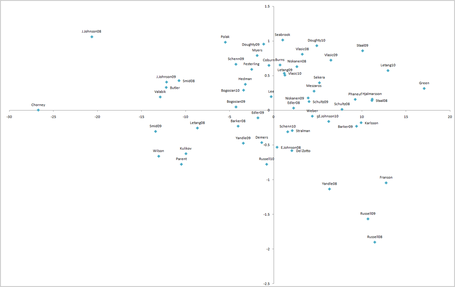Expectations Surrounding Young Defenseman
The Rangers system is currently overloaded with defensemen expected to make some type of impact over the coming years. The movement began a couple of years ago when Marc Staal cracked the lineup as a 21 year old, continued last year with 19 year old Michael Del Zotto, and is expected to continue with the signing of Ryan McDonagh this year. What is not known is how much impact this type of youth can have on your
With advanced statistic data only three years old, we'll focus on that era. Since 2007-08, there have been 40 players and 58 player-seasons where a defenseman has logged at least 40 games at an age of 22 or younger (cutoff date is Feb 1st.) Here's the list of those players:
Age 18 - Zach Bogosian
Age 19 - Erik Johnson, Drew Doughty, Luke Schenn, Dmitri Kulikov, Erik Karlsson, Michael Del Zotto, Tyler Myers, Victor Hedman, Zach Bogosian
Age 20 - Kris Letang, Kris Russell, Marc-Edouard Vlasic, Drew Doughty, Luke Schenn
Age 21 - Alexander Edler, Anton Stralman, Cam Barker, Jack Johnson, Jeff Schultz, Keith Yandle, Ladislav Smid, Marc Staal, Matt Niskanen, Brian Lee, Kris Letang, Kris Russell, Marc-Edouard Vlasic, Erik Johnson, Jason Demers
Age 22 - Andrej Meszaros, Braydon Coburn, Brent Burns, Brent Seabrook, Dion Phaneuf, Mike Green, Shea Weber, Alexander Edler, Andrej Sekera, Boris Valabik, Brett Festerling, Cam Barker, Chris Butler,
More after this...
For continuity with
| Age | Corsi/60 | Rel Corsi | GFON/60 | GAON/60 | GDIFF/60 | QC Rk | QT Rk |
| 18-19 | -1.639 | 0.846 | 2.539 | 2.777 | -0.237 | 3.600 | 4.074 |
| 20 | 2.489 | 0.357 | 2.143 | 2.132 | 0.011 | 4.086 | 4.457 |
| 21 | 1.320 | 0.206 | 2.413 | 2.430 | -0.016 | 3.909 | 3.656 |
| 22 | 1.374 | 0.824 | 2.456 | 2.395 | 0.061 | 3.740 | 3.458 |
For those unfamilar, Corsi is the number of shots minus the number of shots against while a player is on the ice. It includes all shots directed on net, missed nets, and blocked shots. /60 indicates the number distributed evenly for every 60 minutes of even strength ice time the player faces. QC and QT values are based on the Corsi QC/QT numbers, and the ranks here are based on 6 defenseman. In these cases, the numbers indicate mostly 2nd pair levels for both values.
Looking at the stats, the youngest of this group were given the hardest comp on average, the 2nd hardest teammates, yet relative to their
Here's the look for just rookie seasons in the NHL at those ages:
| Age | Corsi/60 | Rel Corsi | GFON/60 | GAON/60 | GDIFF/60 | QC Rk | QT Rk |
| 18-19 | -1.387 | 1.184 | 2.559 | 2.743 | -0.184 | 3.667 | 3.971 |
| 20 | 1.685 | 0.802 | 1.664 | 2.025 | -0.361 | 4.571 | 4.762 |
| 21 | -0.818 | -1.926 | 2.320 | 2.429 | -0.109 | 3.927 | 3.648 |
| 22 | 0.972 | 0.538 | 2.401 | 2.314 | 0.087 | 3.538 | 3.359 |
Similar patterns emerge here. At this point it's worth noting one special season that seriously weighs down the 21 year old numbers.
| Age | Corsi/60 | Rel Corsi | GFON/60 | GAON/60 | GDIFF/60 | QC Rk | QT Rk |
| 21 | -0.818 | -1.926 | 2.320 | 2.429 | -0.109 | 3.927 | 3.648 |
| 21 w/o JJ | 2.129 | 0.821 | 2.338 | 2.324 | 0.014 | 4.170 | 3.563 |
Clearly, the numbers make more sense when you remove that season. Finally, here's the scatterplot of the defenseman, showing their QC when compared to their Corsi rate (click to enlarge):
The x-axis here is the Corsi/60, the Y-axis is the QC. Players in the right half outshoot their competition, and in the top half are playing competition that outshoots their competition. Thus, the top right quadrant is the group that is outplaying the better competition in the NHL, and bottom left is the group that was thrown to the kittens, and got mauled anyway. Marc Staal and M.E. Vlasic? Quite good. Ryan Parent and Ryan Wilson? Not so much. As for
What this all does tell us is that young defenseman are capable of coming into the league and making an impact, as long as they're coming in on their terms. When you are forced into the situation as Edmonton, Colorado, and Phoenix have been over the last couple of years, however, the results can be troubling.
stats credit to behindthenet.ca


